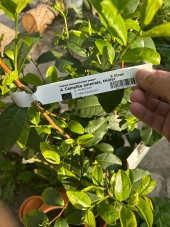




No rain, no rainbow.









Joseph Lofthouse wrote:You are doing this in the USA, not in Japan or China. There are likely to be many complex food handling regulations and building specifications to be complied with. You might get more accurate information by asking your local health/agricultural inspector.
No rain, no rainbow.





Cottage Food Products may only be sold in Ohio.




Joseph Lofthouse wrote:
Cottage Food Products may only be sold in Ohio.
That seems like a pretty narrow distribution market for a product that is not perishable, and that could easily be shipped worldwide.
No rain, no rainbow.





Ryan Hobbs wrote:We have a really huge population of East Asian peoples.




Joseph Lofthouse wrote:
Ryan Hobbs wrote:We have a really huge population of East Asian peoples.
About 3% of Ohio's population is of Asian descent. https://development.ohio.gov/files/research/P7004.pdf That seems like a really small niche market...
No rain, no rainbow.
 1
1





"We're all just walking each other home." -Ram Dass
"Be a lamp, or a lifeboat, or a ladder."-Rumi
"It's all one song!" -Neil Young





 1
1




 2
2




Judith Browning wrote:We are big tea drinkers so love your descriptions of hand rolled tea leaves, the hut and other processes and packaging/labels.
Sounds as though you've put a lot of thought into this. We tend to buy unusual varieties of loose green and black teas when we run across them.
I'm sure there would be many ways to expand out of the state if you ever find you need a larger market. A larger market means more rules of course and many of us have avoided that step.....sounds like just the item for good food stores and some high end markets on line though.
best of luck

No rain, no rainbow.




Ryan Hobbs wrote:
Judith Browning wrote:We are big tea drinkers so love your descriptions of hand rolled tea leaves, the hut and other processes and packaging/labels.
Sounds as though you've put a lot of thought into this. We tend to buy unusual varieties of loose green and black teas when we run across them.
I'm sure there would be many ways to expand out of the state if you ever find you need a larger market. A larger market means more rules of course and many of us have avoided that step.....sounds like just the item for good food stores and some high end markets on line though.
best of luck
Once I get this going, I was planning to send out free samples for review purposes, which is allowed as far as I know for out of state as long as I don't charge for it. If you'd like, I can add ya to my list of tasters. It will take a few years before this happens while we plant the fields, wait for bushes to mature, and fiddle with our processes, but it will eventually happen. And us crafty folk love to share our work with others.

"We're all just walking each other home." -Ram Dass
"Be a lamp, or a lifeboat, or a ladder."-Rumi
"It's all one song!" -Neil Young
 1
1




Glenn Herbert wrote:How much do you know about prices that are supported for your kind of product, and actual sales? How much distribution work would you have to do compared to the actual tea processing? Or could you concentrate distribution and promotion to winter months where you are not working with the tea directly?
For a processing hut, I would go absolute minimal expense until you prove there is a market for your product. Developing onsite tasting obviously requires an attractive tasting room. Would it be feasible to combine the functions in one structure (with separation of functions)? I would envision a rectangle with the back half dedicated to production and storage, while the front half is an elegant setting for tasting. Easy access to view the production facility would probably be a value-added feature to drive sales interest.
Finally, I expect the expense of just the materials, never mind the construction time and expertise, would take some years to be recouped by even good tea sales. Would this structure be something that would enhance your property beneficially even if the tea business fails?
No rain, no rainbow.
 1
1




Ryan Hobbs wrote:The only expenses would be the building permits, mortar, and steel plate for the drying table.
I make a Maple Syrup instructional movie! Check it out HERE
SKIP books, get 'em while they're hot!!! Skills to Inherit Property
See me in a movie building a massive wood staircase:Low Tech Lab Movie
 1
1




No rain, no rainbow.
 2
2






No rain, no rainbow.

 1
1




 1
1




Glenn Herbert wrote:So a four-mat room around a central hearth? I forget, what is the size of a standard tatami mat?
The tasting room looks lovely, and would be an asset with or without business purpose. The drying hut looks simple enough that whatever you decide on the details should be fine. You appear to know enough about traditional construction that your impulses can probably be relied on.
No rain, no rainbow.
 4
4




No rain, no rainbow.

|
30 seconds to difuse a loaf of bread ... here, use this tiny ad:
The new purple deck of permaculture playing cards
https://www.kickstarter.com/projects/paulwheaton/garden-cards
|





